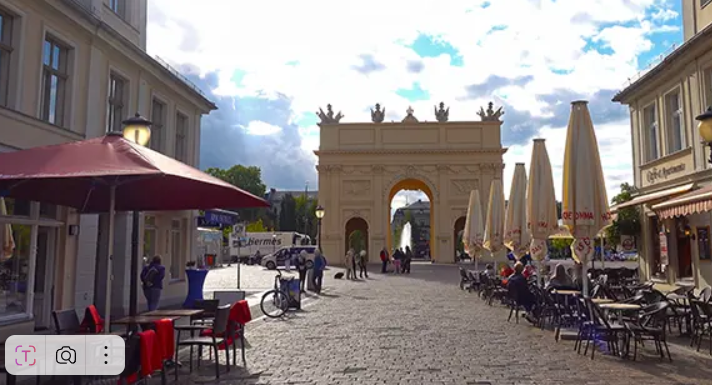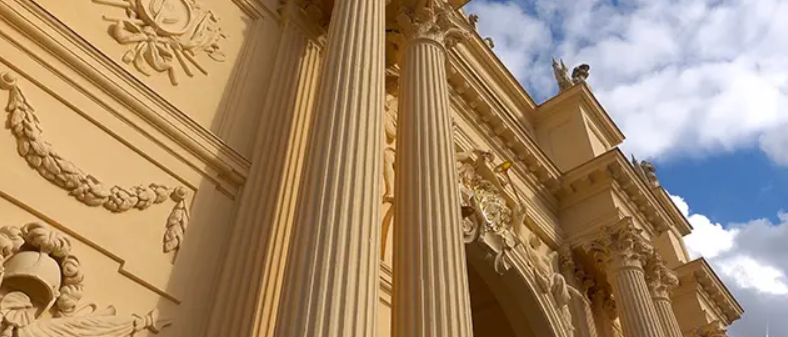The magnificent Brandenburg Gate in Potsdam at the end of Potsdam’s promenade
Address: Brandenburg Gate, Luisenplatz, 14471 Potsdam | Built: 1770 to 1771
The most magnificent city gate in Potsdam is the Brandenburg Gate. It stands at the end of Brandenburger Straße and is considered the end of Potsdam’s promenade. Frederick the Great had the gate built as a triumphal arch to commemorate his victory in the Seven Years’ War, after Silesia had also become part of the Kingdom of Prussia.
The Brandenburg Gate in Potsdam has several special features that make it a unique eye-catcher. The gate was designed by two architects. It was formerly part of the city wall, which was demolished, so that today the Brandenburg Gate dominates Luisenplatz as an imposing structure.
Directions and location of the Potsdam landmark
At the western end of Brandenburger Straße, which runs in a straight line to the Church of St. Peter and Paul, the Brandenburg Gate on Luisenplatz forms an impressive conclusion to the promenade. Not far away, the B2 motorway passes Luisenplatz with its imposing archway. Those who don’t arrive via Brandenburger Straße to visit the landmark can easily reach Luisenplatz via Schopenhauerstraße or Gutenbergstraße. The Brandenburg Gate can also be reached via the avenue leading to Sanssouci Palace or Zimmerstraße.
Opening Hours and Tours
The Brandenburg Gate in Potsdam is open to the public 24 hours a day and can be visited at any time.

Brandenburg Gate Entrance Fees
There is no entrance fee for the Brandenburg Gate in Potsdam.
Guided Tours of the Brandenburg Gate
No guided tours are offered on-site at the Brandenburg Gate in Potsdam. Those who would like to learn more about Frederick the Great’s triumphal arch and make their own independent and individual decisions can download the “Potsdam City Guide” app to their smartphone, save individual tours, and learn a lot about the Brandenburg Gate in Potsdam. The app is free and available in the iTunes App Store for Apple devices and Google Play for Android devices. Since a large amount of data is downloaded, it is best to do so over Wi-Fi.
FAQ – Frequently Asked Questions about the Brandenburg Gate in Potsdam
What is the significance of the Brandenburg Gate in Potsdam?
The Brandenburg Gate in Potsdam was built in the 18th century and is a remnant of the city’s former city fortifications. It is a testament to Prussian history and architecture.
When was the Brandenburg Gate in Potsdam built?
The Brandenburg Gate in Potsdam was built between 1770 and 1771 during the reign of the Prussian King Frederick II, also known as Frederick the Great. It was designed by Carl von Gontard and was part of Potsdam’s city fortifications.
Brandenburg Gate in Potsdam – Special Features and Interesting Facts
The Brandenburg Gate is, along with the Jägertor and the Nauerner Tor, one of the three remaining city gates in Potsdam. Anyone strolling along Brandenburger Straße, Potsdam’s main promenade, to the western end can admire the imposing structure from a distance.
Interestingly, two architects were responsible for the Brandenburg Gate. The exterior, facing Sanssouci Palace, was built according to plans by Georg Christian Unger, while the side facing the city was designed by Carl von Gontard.
As is often the case in Potsdam, the Brandenburg Gate was modeled on Roman antiquity. The gate was designed in the style of the Arch of Constantine in the Roman Forum and was firmly integrated into the city wall as a gateway to the center of Potsdam.
There is a main gate and two side gates. Anyone who takes a closer look at the Brandenburg Gate will immediately notice the classical column architecture, which is very sculptural. This beautifully showcases the gate and makes it a special eye-catcher when approaching from the west. A glance at the attic reveals the heraldic carriage and the lavish war trophies that crown the passage to Brandenburger Straße. On the city side, Gontard decorated the gate with trophies and Corinthian pilaster strips.
On the city side, there is a forecourt in front of the Brandenburg Gate, which is also a special eye-catcher. This was not only used for checking goods and people leaving Potsdam. The forecourt in front of the Brandenburg Gate created a spacious area that perfectly showcased the gate’s architecture.
The so-called Luisenplatz was created under Frederick the Great. Peter Joseph Lenné, who, as a landscape architect, also laid out and designed the palace gardens, was responsible for its design and planting.
The plantings were removed during the paving of the square. Only a few columnar oaks were allowed to remain. Since the comprehensive redesign of Luisenplatz with an underground garage and parking lot between 1999 and 2000, rows of linden trees have been planted on the square. A fountain was installed in the center of the square, making it a pleasant place to linger during the summer months.

Historical Facts and History of the Potsdam Brandenburg Gate
The first Brandenburg Gate was built in 1733 during the second expansion of the city. The country road leading to the city of Brandenburg began on the outside of the Brandenburg Gate. The paths leading to the various Potsdam palaces and palace gardens also converged on the forecourt.
After Frederick the Great had successfully won the Seven Years’ War, he wanted to have a magnificent gate built at the entrance to the city to signal that Prussia was now one of the major European powers.
From 1770 to 1771, the new city gate was built according to plans by Carl von Gontard and Georg Christian Unger and equipped with special elements. A Roman triumphal arch was considered the model for the Brandenburg Gate in Potsdam.
The smaller side passages were opened in the 19th century. They formerly housed a guardroom and the royal customs office. After the city wall was demolished, the Brandenburg Gate now stood freely on the square and thus took on an even more impressive effect.


Sights and attractions in the immediate vicinity of the Brandenburg Gate in Potsdam
If you take a closer look around the area around the Brandenburg Gate, you’ll come across interesting and worth-seeing buildings, both in the immediate vicinity and within walking distance, and discover many things that only become apparent upon closer inspection.
Directly in front of the Brandenburg Gate is a lavish fountain with a diameter of 16 meters. The water jet reaches a height of up to 8 meters. Due to its central location, the square with the fountain in front of the Brandenburg Gate is used for many activities and festivals. Around the fountain are several restaurants with outdoor terraces that invite you to linger.
A few minutes’ walk from the Brandenburg Gate is the Jägertor (Hunter’s Gate). It is the only city gate that has been preserved in its original form. Anyone who takes a closer look at the Jägertor (Hunter’s Gate) will quickly notice the special decoration that crowns the gate. It depicts a par force hunt, which was extremely popular at the time.
Continuing along Hegelallee, you’ll automatically reach the Nauen Gate on Friedrich-Ebert-Straße. This striking neo-Gothic city gate features two imposing towers located directly next to the main entrance. The Dutch Quarter is located in the immediate vicinity of the Nauen Gate.
Cafés and Restaurants Near the Brandenburg Gate
Long walks and sightseeing tours come to a special end when you can quench your thirst and hunger in the shadow of the Brandenburg Gate with an exceptional view of the building. Numerous restaurants have set up shop in the immediate vicinity of the Brandenburg Gate and Luisenplatz to ensure your culinary well-being. In summer, the outdoor terraces are open for guests to linger and enjoy the beautiful weather.
Viennese Restaurant and Café
The Viennese Restaurant and Café is located directly on Luisenplatz and is a sidewalk café in the Viennese coffee house style. In addition to coffee specialties, there is also a lovely selection of cakes and delicious gateaux. Those who don’t fancy cake can choose from the menu to satisfy their hunger in a cozy atmosphere.
Address: Viennese Restaurant and Café, Luisenplatz 4
Restaurant Contadino
Italian specialties such as carpaccio, delicious salads, pasta, and pizza are served at the Contadino restaurant on Luisenplatz. A fine selection of wines, beers, and soft drinks is also available. Sitting inside in a cozy atmosphere or enjoying the view of the Brandenburg Gate on the outdoor terrace in good weather perfectly rounds off a visit to the Brandenburg Gate.
Address: Restaurant Contadino, Luisenplatz 8
Cuhibar at Luisenplatz
The Cuhibar at Luisenplatz is different from other dining establishments, as it is a bar that offers not only unique cocktails but also delicious Cuban dishes. There are typical snacks, salads, burgers, borlottos, and tapas, which can be enjoyed in a tasteful Cuban atmosphere or on the spacious outdoor terrace.
Address: Cuhibar at Luisenplatz, Luisenplatz 7
Restaurant Chi Keng
Located on Luisenplatz, Chi Keng features a beautiful outdoor terrace. The menu offers guests Vietnamese classics such as crispy duck, pho noodles, sashimi, and sushi, all served in a casual atmosphere. Vegetarian and vegan dishes, a wide selection of teas, and alcoholic and non-alcoholic beverages are also available.
Address: Restaurant Chi Keng, Luisenplatz 3
Restaurant Assaggi
Located on Luisenplatz, Assaggi features an attractive, modern interior and a beautiful outdoor terrace where you can sit outside and enjoy the day in good weather, feasting on culinary Italian delicacies. The menu includes sophisticated pasta dishes, delicious fish and meat dishes, and a fine selection of wines.
Address: Restaurant Assaggi, Luisenplatz 3